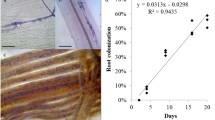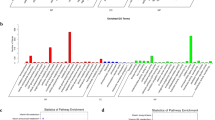Abstract
Different arbuscular mycorrhizal fungi (AMF) alter growth and nutrition of a given plant differently. Plant gene expression patterns in response to fungal colonization show a certain overlap when colonized by fungi of the Glomeraceae. However, little is known of plant responses to fungi of different fungal taxa, e.g. the Gigasporaceae. We therefore compared the impact of colonization by three taxonomically different AMF species (Glomus intraradices, Glomus mosseae and Scutellospora castanea) on Medicago truncatula at the physiological and transcriptional level using quantitative-PCR. Each AMF developed a species-typical colonization pattern, with a colonization degree of 60% for G. intraradices and 30% for G. mosseae. Both species developed appressoria, intraradical hyphae, arbuscules and vesicles. S. castanea showed a colonization degree of 10% and developed appressoria, intraradical hyphae, arbuscules and arbusculate coils. All AMF enhanced the plant biomass accumulation and nutritional status although not in correlation with the colonization degree. The expression of 10 mycorrhiza-specific or mycorrhiza-associated plant genes could be separated into two clusters. The first cluster, containing arbuscule-induced genes, was highly induced in interactions with G. intraradices and G. mosseae but also slightly induced by S. castanea. The second cluster of genes contained genes that were induced primarily by S. castanea. In conclusion, genes that respond to colonization by fungi of the genus Glomus also respond to Scutellospora. However, there is also a group of genes that is significantly induced only by Scutellospora and not by Glomus species in this study. Our data indicate that genes may be differentially regulated in response to the different AM fungi.


Similar content being viewed by others
Abbreviations
- AM:
-
Arbuscular mycorrhiza
- AMF:
-
Arbuscular mycorrhizal fungus
- G.:
-
Glomus
- Gi:
-
G. intraradices
- Gi.:
-
Gigaspora
- Gm:
-
G. mosseae
- S.:
-
Scutellospora
- Sc:
-
S. castanea
- P:
-
Phosphorus
- N:
-
Nitrogen
References
Boerjan W, Ralph J, Baucher M (2003) Lignin biosynthesis. Annu Rev Plant Biol 54:519–546
Bonanomi A, Wiemken A, Boller T, Salzer P (2001) Local induction of a mycorrhiza-specific class III chitinase gene in cortical root cells of Medicago truncatula containing developing or mature arbuscules. Plant Biol 3:194–199
Broughton WJ, John CK (1979) Rhizobia in tropical legumes III. Experimentation and supply in Malaysia 1927–1976. In: Broughton WJ, John CK, Lim B, Rajova C (eds) Soil microbiology and plant nutrition, University of Malaysia, Kuala Lumpur pp 113–136
Burleigh SH, Harrison MJ (1999) The down-regulation of Mt4-like genes by phosphate fertilization occurs systemically and involves phosphate translocation to the shoots. Plant Physiol 119:241–248
Burleigh SH, Cavagnaro T, Jakobsen I (2002) Functional diversity of arbuscular mycorrhizas extends to the expression of plant genes involved in P nutrition. J Exp Bot 53:1593–1601
Chiou TJ, Liu H, Harrison MJ (2001) The spatial expression patterns of a phosphate transporter (MtPT1) from Medicago truncatula indicate a role in phosphate transport at the root/soil interface. Plant J 25:281–293
Dickson S (2004) The Arum-Paris continuum of mycorrhizal symbioses. New Phytol 163:187–200
Elfstrand M, Feddermann N, Ineichen K, Nagaraj VJ, Wiemken A, Boller T, Salzer P (2005) Ectopic expression of the mycorrhiza-specific chitinase gene Mtchit3–3 in Medicago truncatula root-organ cultures stimulates spore germination of glomalean fungi. New Phytol 167:557–570
Gao LL, Delp G, Smith SE (2001) Colonization patterns in a mycorrhiza-defective mutant tomato vary with different arbuscular-mycorrhizal fungi. New Phytol 151:477–491
Gao LL, Knogge W, Delp G, Smith FA, Smith SE (2004) Expression patterns of defense-related genes in different types of arbuscular mycorrhizal development in wild-type and mycorrhiza-defective mutant tomato. Mol Plant Microbe Interact 17:1103–1113
Giovannetti M, Mosse B (1980) An evaluation of techniques for measuring vesicular arbuscular mycorrhizal infection in roots. New Phytol 84:489–500
Grunwald U, Nyamsuren O, Tarnasloukht M, Lapopin L, Becker A, Mann P, Gianinazzi-Pearson V, Krajinski F, Franken P (2004) Identification of mycorrhiza-regulated genes with arbuscule development-related expression profile. Plant Mol Biol 55:553–566
Harrison MJ (1996) A sugar transporter from Medicago truncatula: Altered expression pattern in roots during vesicular-arbuscular (VA) mycorrhizal associations. Plant J 9:491–503
Harrison MJ (1999) Molecular and cellular aspects of the arbuscular mycorrhizal symbiosis. Annu Rev Plant Physiol Plant Mol Biol 50:361–389
Harrison MJ, Dewbre GR, Liu JY (2002) A phosphate transporter from Medicago truncatula involved in the acquisiton of phosphate released by arbuscular mycorrhizal fungi. Plant Cell 14:2413–2429
Hart MM, Reader RJ (2002) Host plant benefit from association with arbuscular mycorrhizal fungi: variation due to differences in size of mycelium. Biol Fertil Soils 36:357–366
Hohnjec N, Becker JD, Pühler A, Perlick AM, Küster H (1999) Genomic organization and expression properties of the MtSucS1 gene, which encodes a nodule-enhanced sucrose synthase in the model legume Medicago truncatula. Mol Gen Genet 261:514–522
Hohnjec N, Perlick AM, Pühler A, Küster H (2003) The Medicago truncatula sucrose synthase gene MtSucS1 is activated both in the infected region of root nodules and in the cortex of roots colonized by arbuscular mycorrhizal fungi. Mol Plant Microbe Interact 16:903–915
Hohnjec N, Vieweg ME, Pühler A, Becker A, Küster H (2005) Overlaps in the transcriptional profiles of Medicago truncatula roots inoculated with two different Glomus fungi provide insights into the genetic program activated during arbuscular mycorrhiza. Plant Physiol 137:1283–1301
Karandashov V, Nagy R, Wegmüller S, Amrhein N, Bucher M (2004) Evolutionary conservation of a phosphate transporter in the arbuscular mycorrhizal symbiosis. Proc Natl Acad Sci USA 101:6285–6290
Küster H, Hohnjec N, Krajinski F, El Yahyaoui F, Manthey K, Gouzy J, Dondrup M, Meyer F, Kalinowski J, Brechenmacher L, van Tuinen D, Gianinazzi-Pearson V, Pühler A, Gamas P, Becker A (2004) Construction and validation of cDNA-based Mt6k-RIT macro- and microarrays to explore root endosymbioses in the model legume Medicago truncatula. J Biotechnol 108:95–113
Liu JY, Blaylock LA, Endre G, Cho J, Town CD, VandenBosch KA, Harrison MJ (2003) Transcript profiling coupled with spatial expression analyses reveals genes involved in distinct developmental stages of an arbuscular mycorrhizal symbiosis. Plant Cell 15:2106–2123
Liu J, Maldonado-Mendoza I, Lopez-Meyer M, Cheung F, Town CD, Harrison MJ (2007) Arbuscular mycorrhizal symbiosis is accompanied by local and systemic alterations in gene expression and an increase in disease resistance in the shoots. Plant J 50:529–544
Massoumou M, van Tuinen D, Chatagnier O, Arnould C, Brechenmacher L, Sanchez L, Selim S, Gianinazzi S, Gianinazzi-Pearson V (2007) Medicago truncatula gene responses specific to arbuscular mycorrhiza interactions with different species and genera of Glomeromycota. Mycorrhiza 17:223–234
Munkvold L, Kjoller R, Vestberg M, Rosendahl S, Jakobsen I (2004) High functional diversity within species of arbuscular mycorrhizal fungi. New Phytol 164:357–364
Oehl F, Sieverding E, Ineichen K, Mäder P, Boller T, Wiemken A (2003) Impact of land use intensity on the species diversity of arbuscular mycorrhizal fungi in agroecosystems of Central Europe. Appl Environ Microbiol 69:2816–2824
Ohnishi ST, Gall RS (1978) Characterization of the catalyzed phosphate assay. Anal Biochem 88:347–356
Phillips JM, Hayman DS (1970) Improved procedures for clearing roots and staining parasitic and vesicular-arbuscular mycorrhizal fungi for rapid assessment of infection. Trans Br Mycol Soc 55:158–161
Redecker D (2002) Molecular identification and phylogeny of arbuscular mycorrhizal fungi. Plant Soil 244:67–73
Salzer P, Bonanomi A, Beyer K, Vögeli-Lange R, Aeschbacher RA, Lange J, Wiemken A, Kim D, Cook DR, Boller T (2000) Differential expression of eight chitinase genes in Medicago truncatula roots during mycorrhiza formation, nodulation, and pathogen infection. Mol Plant Microbe Interact 13:763–777
Salzer P, Feddermann N, Wiemken A, Boller T, Staehelin C (2004) Sinorhizobium meliloti-induced chitinase gene expression in Medicago truncatula ecotype R108-1: a comparison between symbiosis-specific class V and defence-related class IV chitinases. Planta 219:626–638
Schüssler A, Schwarzott D, Walker C (2001) A new fungal phylum, the Glomeromycota: phylogeny and evolution. Mycol Res 105:1413–1421
Smith SA, Read DJ (1997) Mycorrhizal symbiosis. Academic, San Diego
Smith SE, Smith FA, Jakobsen I (2004) Functional diversity in arbuscular mycorrhizal (AM) symbioses: the contribution of the mycorrhizal P uptake pathway is not correlated with mycorrhizal responses in growth and total P uptake. New Phytol 162:511–524
Watanabe FS, Olsen RS (1965) Test of an ascorbic acid method for determining phosphorus in water and NaHCO3 extracts from soil. Soil Sci Soc of Am Proc 29:677–678
Wulf A, Manthey K, Doll J, Perlick AM, Linke B, Bekel T, Meyer F, Franken P, Küster H, Krajinski F (2003) Transcriptional changes in response to arbuscular mycorrhiza development in the model plant Medicago truncatula. Mol Plant Microbe Interact 16:306–314
Acknowledgments
We would like to thank Kurt Ineichen (University of Basel, Basel, Switzerland) for maintaining and providing the fungal inoculum and Dr. Petra M. A. Fransson and Dr. Andrew F. S. Taylor (Swedish University of Agricultural Sciences, Department of Forest Mycology and Pathology, Uppsala, Sweden) for reading and commenting on the manuscript. M.E. is financed by a grant from the Swedish Research Council for Environment, Agricultural Sciences and Spatial Planning. Work at the University of Basel was supported by grants of the Swiss National Science Foundation to T.B. and A.W.
Author information
Authors and Affiliations
Corresponding author
Rights and permissions
About this article
Cite this article
Feddermann, N., Boller, T., Salzer, P. et al. Medicago truncatula shows distinct patterns of mycorrhiza-related gene expression after inoculation with three different arbuscular mycorrhizal fungi. Planta 227, 671–680 (2008). https://doi.org/10.1007/s00425-007-0649-1
Received:
Accepted:
Published:
Issue Date:
DOI: https://doi.org/10.1007/s00425-007-0649-1




